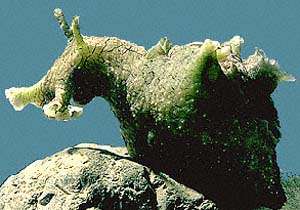

What are Sea Hares?
Order: ANASPIDEA
Superfamily: APLYSIOIDEA
DISTRIBUTION
All around the world in temperate and tropical waters.
PHOTO
UPPER: Aplysia dactylomela. With a bit of imagination this does look a bit like a hare or a rabbit, although the erect head tentacles (rhinophores) are a bit small for ears. (Koumac, New Caledonia, October 1993).
LOWER: Aplysia parvula, showing the typical oral tentacles at the front of the head, on either side of the mouth and the smaller rhinophores just above the eyes. At the back you can see the large parapodial flaps which have a dark brown edge. These parapodia enclose the mantle cavity in which the fragile plate-like shell is found. In this photo, part of a brown ring can be seen. This outlines the hole (foramen) which leads to the cavity in which the shell is found. (southern Tasmania, February 1984). Photos: Bill Rudman.
This is a page for general messages about Sea Hares. See also Page 2.
The Sea Hares, consist of 9 genera: Aplysia, Bursatella, Dolabella, Dolabrifera, Notarchus, Petalifera, Phyllaplysia, Stylocheilus and Syphonota. They range in size from species growing less than 2 cm, to large species which reach over 70 cm in length. They usually have a head bearing a pair of enrolled rhinophores, and large flattened, enrolled oral tentacles on each side of the mouth. The shell, when present, is reduced to a thinly calcified internal plate over the gill and heart. This very reduced mantle cavity is enveloped in a pair of large parapodial lobes, which in some genera are partially fused to form a secondary parapodial chamber.
These animals have been called 'Sea Hares' since classical times because of their resemblance - at least in European species - to a sitting hare.
For further information on these animals go to the General Topics list.
You should be familiar with Kandel's two books which are important resources both for physiologists and biologists:
-
Kandel, E.R. (1976) Cellular Basis of Behaviour. An introduction to behavioural neurobiology. W.H.Freeman & Co., San Francisco. 727 pages.
-
Kandel, E.R. (1979) Behavioural Biology of Aplysia. San Francisco, W.H.Freeman & Co. 463pp.
Rudman, W.B., 1998 (April 14) What are Sea Hares?. [In] Sea Slug Forum. Australian Museum, Sydney. Available from http://www.seaslugforum.net/factsheet/seahares
Related messages
-
Seahare from Singapore
From: Ron Yeo, March 27, 2007 -
Mystery 'thing' from southern New South Wales.
From: John Ringk, January 12, 2007 -
Are sea slugs poisonous?
From: Tess, January 5, 2007 -
Sea Hare in aquarium - possible trauma
From: Jose Rodriguez, December 14, 2006 -
Sea Hare from Mexico
From: Valerie Simpson, June 7, 2006 -
Sea Hare in aquarium
From: Dominic Chen, March 25, 2006 -
Re: Sea hares bioprospecting
From: Tom Hinchey, March 6, 2006 -
Re: Sea hares bioprospecting
From: Skip Pierce, March 1, 2006 -
Sea hares bioprospecting
From: Tom Hinchey, February 28, 2006 -
California Freshwater Slug?
From: Jason Sabo, July 25, 2005 -
Owning my very own Aplysia
From: Aaran Kelley, September 3, 2002 -
Aplysia siphon
From: Angie Berg, June 15, 2002 -
Seahares? in Florida
From: Kathy, June 1, 2002 -
Reddish brown blob from California
From: Jeanne Frederick, May 30, 2002 -
Ancestors of Aplysia
From: Stephen Hoskins, May 28, 2002 -
What do sea slugs eat?
From: Bill Ballard, May 28, 2002 -
How many Sea Hare species are there?
From: Nathan Loomer, May 24, 2002 -
Sea Hare from Wales
From: Warren Fairclough, April 3, 2002 -
Aplysia and memory?
From: Jay, November 28, 2001 -
What do Sea Hares eat?
From: Danny, July 1, 2001 -
Need info about memory experiment on Aplysia
From: G.Cormier, September 23, 1999 -
Sea Hares from the Marianas Islands
From: Gary Hewitt, July 28, 1999 -
Re: Info on Sea Hares
From: Joel Beasley, May 15, 1999 -
Info on Sea Hares
From: Joel Beasley, May 14, 1999 -
Medical Uses of Sea Slugs
From: Jonathan Choi, May 13, 1999 -
Sea Hares? from Jervis Bay, New South Wales
From: Terese and Ngaere, April 28, 1999 -
Nudibranch
From: Dana Cianfrani, April 13, 1999 -
Information on Aplysia in Chile
From: Soledad De La Piedra, March 30, 1999 -
Sea Hare research
From: Cary Rogers, February 17, 1999 -
Re: Sea Slugs in Florida
From: Bob Pellegrino, February 15, 1999 -
Sea Slugs in Florida
From: Bob Pellegrino, February 11, 1999 -
Where do I buy Sea Hares?
From: Dallas Carlon, January 12, 1999 -
We need information on Sea Slugs (Hares)
From: Jim Fitzpatrick, December 18, 1998 -
Re: NIH-Aplysia Resource Facility
From: Tom Capo, December 8, 1998 -
Re: NIH-Aplysia Resource Facility
From: Tom Capo, December 6, 1998 -
Want to buy Sea Hares!
From: Bill Rudman, December 5, 1998 -
I need specimens of Aplysia cervina
From: Sara Black Banks, November 20, 1998 -
Sea Hares
From: Sara Loeffler, September 9, 1998 -
Sea slug or something else?
From: Sandi, August 15, 1998 -
Re: How many eggs can a sea hare lay
From: Kathy Potter, June 2, 1998 -
How many eggs can a sea hare lay (2)
From: Teri Taylor, June 2, 1998 -
Re: How many eggs can a sea hare lay (2)
From: Teri Taylor, June 2, 1998 -
How many eggs can a sea hare lay
From: Kathy Potter, June 1, 1998 -
Re: Sea Hares - what are they?
From: Rhiana N. VanDoren, May 24, 1998 -
Sea Hares - what are they?
From: Rhiana N. VanDoren, April 14, 1998
